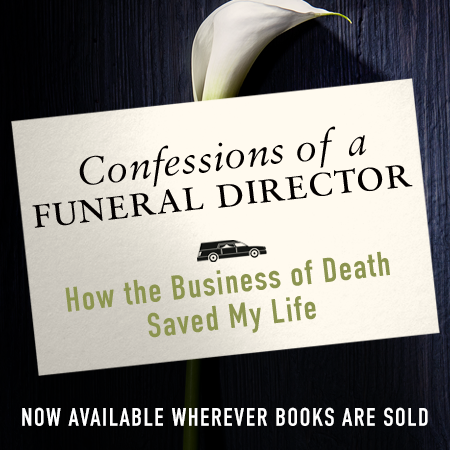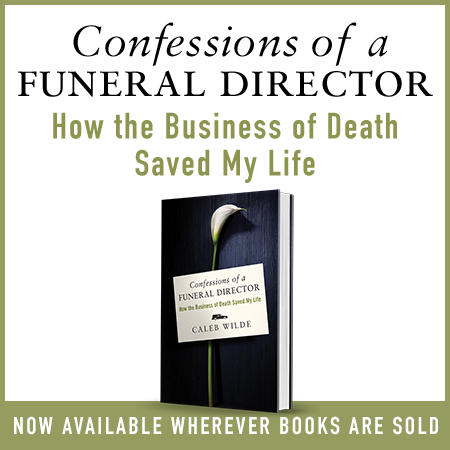Caleb Wilde
(218 comments, 980 posts)
Posts by Caleb Wilde
10 Horrible (and somewhat funny) Versions of Hell
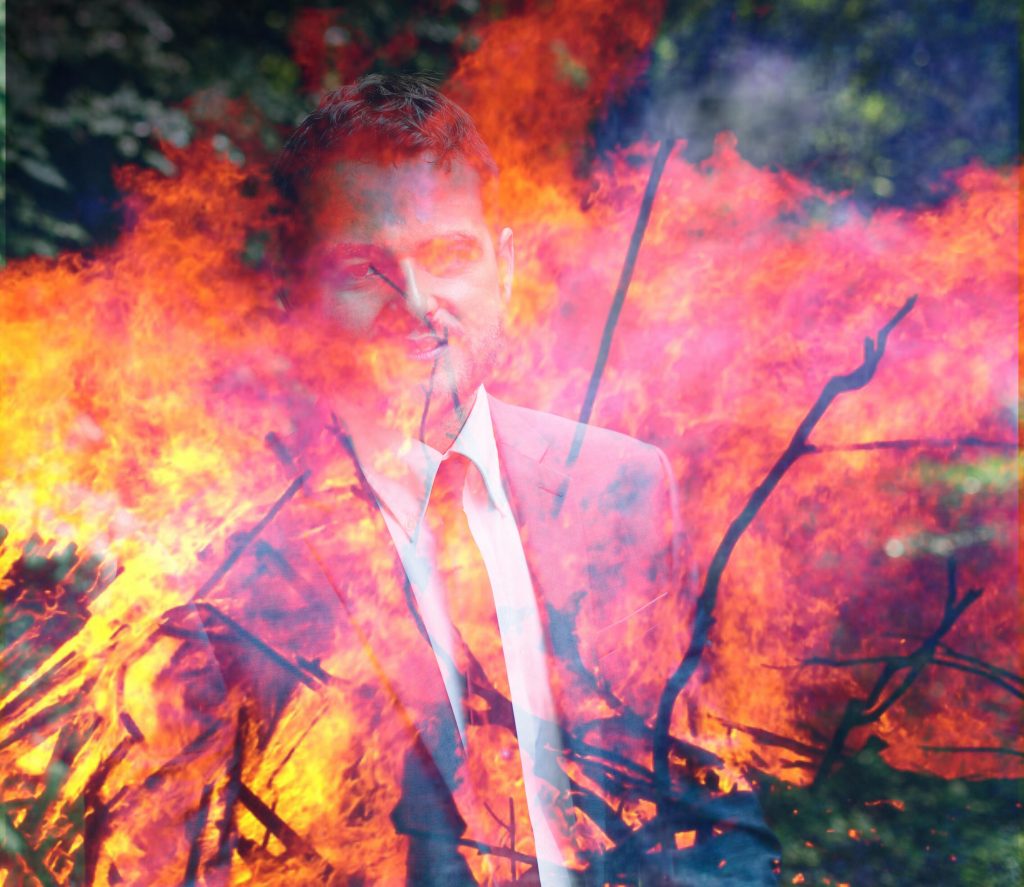
Here’s the hustle of bad religion: The scarier religion makes death (and what comes after it), the more you buy into their message, and the more you’re obedient to their precepts. So much of our death shaming comes from the temples, holy books, and firey teachers of religion that have to heighten your fear to garner your obedience. Death, and what comes after it, has to be horrible to make it all work. On the other hand, once you lose your fear of death (and fear of hell), bad religion loses its power over your mind, and you can gravitate towards healthy religion or none at all.
When the reality of hell comes to a head at funerals, I don’t think we actually think anyone goes to hell. Sure, many religious people believe in hell, but few actually believe THEIR family and THEIR friends and THEIR community go there. I write in my book, that of the thousands of funerals I’ve worked, “I have never once heard a pastor state conclusively that the person they are memorializing was going to hell … pastors have done some fancy preaching for those who have lived less than generous, kind, and loving lives.” Hell may exist as an idea, but — for most — it doesn’t exist as a reality.
Maybe it’s time we jettison the idea too. I mean, have you read some of the ideas of hell? They’re so horrible it’s almost funny. It’s like stuff made up to scare to children …
One. In Dante’s Inferno (a great book that Disney should animate [fingers-crossed]), there are a whole lot of scare-the-disobedience-out-of-you descriptions of hell. My personal favorite? If you were a flatterer in life, you will live in a sea of poop when you die … which means that politicians (who are known to be full of crap) will go to a place as shitty as their promises.
Two. Also of note in Dante’s Inferno: If you commit suicide, you’re turned into a living thorn bush that is constantly eaten by birds. I have not idea if such a punishment is even painful (I mean, maybe I want to be eaten by birds if I’m full of thorns because at least I’m not entirely isolated by my thorniness), but I do know these special types of punishment for suicide helped create the shame culture surrounding suicide. Let’s be clear: suicide (and suicidal attempts) does not deserve punishment from us, or the gods.
Three. Chinese Taoism has a hell funhouse that consists of 19 levels with varying degrees of mutilation. In one such level, you get thrown off a cliff where you’ll eventually land on a ground made of knives. To review: if the impact from falling off a cliff doesn’t kill you, the knives will.
Four. Taoism has another level where you’re continuously dismembered, and THEN crushed by giant rocks, and THEN fed through dismemberment machines, and THEN run over by chariots … just in case the dismemberment, rocks, and machines didn’t hurt enough.
Five. Niflheim in Norse mythology is probably the version that frightens me the most because instead of being hot, it’s VERY, VERY cold. My greatest fear — aside from the existential void of meaninglessness — is not having enough blankets on a cold night. To make Niflheim even more frightening, they added a snake that goes around eating people. Extreme cold. Deadly snakes. Yikes.
Six. Now the Jewish “Gehenna” has some teeth to it. “Gehenna” was a place outside of Jerusalem. At one point in the history of Judaism, some Jewish kings decided to worship the god Moloch, who — didn’t demand wheat, goats, and money like the “nice” gods of the ancients — but babies. They’d heat up a large skillet and threw their children into the skillet in sacrifice to Moloch. When “Gehenna” was mentioned throughout the Bible, the image of hot skillets and burning children is the image that would be conjured in the minds of the Jews.
Seven. Moving on from Gehenna, I present to you Diyu, the Chinese hell with 18 different levels, with each level having a different torture chamber, all of which sound like an S&M dungeon. There’s the chamber of ripping, the chamber of knives, the chamber of ice, the chamber of pounding, and the chamber of uncomfortably tight latex.
Eight. The Babylonians clearly didn’t understand the political value of hell. In fact, it sounds like they were just a bunch of self-loathing Calvinists who believed that all of us deserve it. Because, for the Babylonians, everyone — from the best to the worst — ended up going to the bad place.
Nine. Avici was hell for certain sects of Buddism. It wasn’t eternal like some of the Christian versions, but it still lasted trillions of years. But, unlike most other hells, YOU COULD ACTUALLY DIE IN AVICI. Unfortunately, you’d be reborn in the same place only to suffer torment unto death all over again. It’s basically Bill Murray’s Groundhog Day as a horror movie.
Ten. One of the Hindu ideas of hell is called “Narak”, a place of 23 different levels of torture. One such level consists of constant diarrhea. I’ve been to Mexico. I’ve had Montezuma’s Revenge, and it’s not all that horrible. But have you ever had to do a number three and there was no toilet in sight? That. Is. Living. Hell. And if that’s what Narak consists of, I’m truly frightened and I’ll be a good boy to avoid it.
I don’t believe that afterlife hell exists. If you do believe in it, I hope you’ve grown out of it. In other words, I hope that hell doesn’t have a hold on you because this is literally the control system of immature children, or disobedient dogs. It’s the most base form of human motivation: fear. And as long as we fear death, and what (doesn’t) come after it, we’ll never be able to enjoy life, nor will we ever be able to have a good relationship with death.
****
Some of this content comes from my book, “Confessions of a Funeral Director.” Click the picture below to read more:
Flowers for Mom
By Karen Wyatt MD
The email arrived today, just as it always does, 5 days before my mother’s birthday: “It’s time to order flowers for Margaret!” The florist that sends this reminder has been in business in my hometown for over 100 years and has provided flowers for every birthday, wedding and funeral in my family for as long as I can remember.
I search through the available bouquets featured in the email: Sunny Siesta, Fields of Autumn, Country Sunrise, Butterfly Effect. I think Fields of Autumn is perfect, with orange lilies, green hydrangeas and yellow dahlias. Mom will love the colors and the wild, just-picked look of the arrangement.
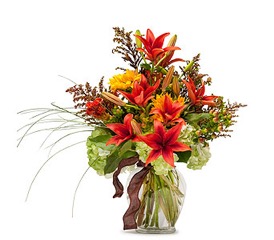 But this year marks the fifth year that I won’t be sending mail order flowers to Mom; the fifth birthday when I won’t be calling her and hearing about her special celebrations with friends; the fifth year since her death, when I mark her birthday by lighting an orange candle in a private celebration of my own.
But this year marks the fifth year that I won’t be sending mail order flowers to Mom; the fifth birthday when I won’t be calling her and hearing about her special celebrations with friends; the fifth year since her death, when I mark her birthday by lighting an orange candle in a private celebration of my own.
Each year when the email reminder arrives I feel a familiar twinge of pain and loneliness as I imagine how Mom’s face would light up when she opened the front door to receive the flowers I’ve chosen for her. I can see her placing the bouquet on her kitchen table, near the window where she always looked out to watch me play in the park across the street.
I wonder why the florist doesn’t know that Mom has died? They provided all of the flowers for her funeral, including the casket spray she had ordered and paid for several years before her death. I’m sure some people would be upset about the automated emails they send every September, but somehow I’ve grown to cherish them.
Choosing a special birthday bouquet for Mom is a long-held ritual for me and it’s one of the last connections I have to our relationship. There’s an indescribable emptiness that occurs with the death of the only person who loves every school photo of you, including the ones with missing teeth, pigtails, and geeky glasses; when the only person who would save your report cards and crayon drawings in the bottom of her lingerie drawer is gone; when you can never again feel the relief that comes from the sound of her voice calling you “honey” over the telephone.
Mom’s belongings, the special treasures that she had gathered over her lifetime, were sorted and scattered within a few months of her death. And her house, where I spent my childhood, has been remodeled by its new owners. The kitchen window no longer exists and the bedroom where she died is now unrecognizable. The cabin in the mountains where we used to camp and fish is now the playground of some other family. There is no longer a physical place that holds my memories.
But in my imagination Mom still opens the front door for the deliveryman and claps her hands with joy over the Fields of Autumn bouquet he holds out to her. She still clears a special spot on the table where the sunlight will show off the orange and yellow blossoms and arranges the attached card so that everyone can see who sent her birthday flowers. She still sits patiently in her reclining chair with the telephone in her lap, waiting for my birthday call. And I still whisper “I love you Mom,” as I celebrate the fact that she was born on September 23rd – born to live a life of love and to one day be my mother and raise me to be a mother as well.
So this year as I study the floral arrangements available to order and choose the perfect flowers for Mom, I have one lingering hope: that the florist keeps sending my reminder email every September. To them I say: thank you for still remembering my Mom’s special day, for helping me maintain my last remaining tribute to her and for the way my face lights up with joy each September 23rd when I see the orange and yellow colors of the Fields of Autumn bouquet.
About the Author:
Dr. Karen Wyatt is a hospice and family physician who writes extensively on spirituality and medicine, especially at the end-of-life. She is the host of End-of-Life University Interview Series and author of “The Tao of Death” and the award-winning book “What Really Matters: 7 Lessons for Living from the Stories of the Dying” Connect with her at karenwyattmd.com, on Facebook at fb.com/KarenWyattMD and on Twitter @spiritualmd
All Souls Day: Giving Our Dead a Place at the Table
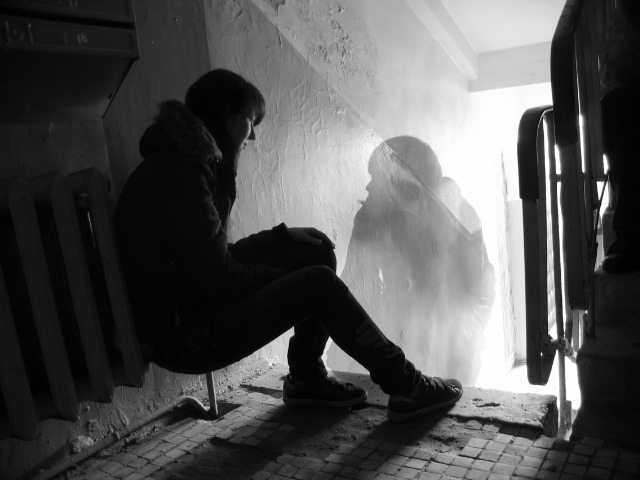
Author: jzool
Author URL: https://www.flickr.com/people/jzool/
Title: she and a ghost
Year: 2008
A couple years ago, my funeral home buried a saint named Jennifer. As far as I know, she didn’t perform any supernatural miracles, like turning water into wine, but she did a kind of miracle that suspends our natural evolutionary tendencies. Per the testimony of her family, she performed her miracles with everyone she met, far surpassing the two-miracle quota required for official canonization.
Jennifer had Down syndrome. Most of the people I know with Down syndrome have a beautifying effect on their family and friends. It’s not necessarily because DS produces more happiness (studies show that depression plagues those with DS), nor is it because caring for someone with DS makes everything easier (although there are reports that divorce rates drop in families that have a DS member), but it seems that position prominence, egotism, and power hunger have little persuasion on these treasured saints of humanity. It’s as if that extra chromosome 21 provides a trade-off, where there’s less mental capability but more character capacity, providing immunity to that desire for survival at other’s expense. And Jennifer had this spades.
Jennifer lived with her parents, Kathy and Don, who were both in their late seventies and retired. On a humid Pennsylvania morning, Don went to wake Jennifer for breakfast and found her lying peacefully in her bed with no apparent signs of a struggle. She was dead.
Jennifer was taken to our county’s morgue where the coroner did her work in trying to determine the cause of death. When a deceased person is a coroner’s case, if the cause of death isn’t entirely apparent, the final cause of death – and the final death certificate – is not issued for a couple weeks while the toxicology tests await their results.
Kathy and Don entrusted my grandfather, my dad and I with Jennifer’s funeral arrangements. Funerals are like a living mosaic. You give away pieces of yourself throughout your life and sometimes many of these pieces come back to form a living piece of artwork … at a funeral. I’ve worked a number of funerals throughout my 15 years at my family’s funeral home, but Jennifer’s display was a masterpiece. This group of people that gathered for Jennifer’s funeral – her living mosaic — created a wonderful aura of kindness, understanding, and togetherness.
In our culture, these living mosaics take place just once in the form of a funeral. And that’s it. But even funerals are becoming less and less engrained in our cultural ethos – for a reason I can’t entirely put my finger on – we’re slowly moving the dead out of the spaces of the living. Maybe we think it’s morbid to give the dead space? Maybe we’d just rather forget … or we think remembering is too painful? Maybe we think this ostracization is a part of closure?
When we do remember, it’s often something that we stumble upon, passively, and hardly ever corporately. We smell our dad’s cologne in a crowded street and we’re suddenly brought to tears. We find a picture of our grandmother stuffed in our desk and our mind is flooded with memories. As beautiful and cathartic as these passive experiences can be, I’d like to think that it would be even healthier if we invited our dead into our spaces through a more active form of remembering like Kathy and Don did with Jennifer when they gave her a communal space even after her death.
A couple weeks after Jennifer’s funeral, the final death certificates arrived at our funeral home with “sudden cardiac arrest due to sleep apnea” inscribed as Jennifer’s cause of death, a cause that was expected now finalized. I called Kathy and let her know I’d be willing to bring the death certificates to her house, she agreed and an hour later she and her husband welcomed me into their home to show me something they made for Jennifer. I write about what I saw in my book:
“Come into the kitchen, she said. I walked through the archway into the kitchen and saw something I’d never seen before. Jennifer’s place at the kitchen table was covered with a shrine – a collection of items that had been meaningful to Jennifer. I had associated a shrine with the worship of a demigod or saint, but Jennifer’s family took the broader meaning. They dedicated this spot entirely to the memory of their daughter.
“We thought it’d be a good idea,” Kathy said. I was slightly taken aback by the whole thing. If you had asked me the first word that came to mind when I saw it, I would have said ‘weird’, maybe even ‘pathological’. But after Kathy started to explain the different parts of the shrine and their meaning, I understood my reaction had been hasty.
Looking back, I see that my initial problem with Jennifer’s shrine was that it didn’t portray that strong American sense of tackling and overcoming grief. Americans love to problem-solve, and we hate sitting in the tension, and many of us, even some therapists, see grief as a problem that needs solving, a wound that needs healing, and a chapter that needs closure. But Jennifer’s shrine stood in the tension of avoidance and closure and acknowledged that grief is present, it’s present in this home, and that’s okay.
Somewhat unknowingly, Kathy and Don were practicing All Souls Day, the day some believers actively give their dead space among the living. Days like All Saints and All Souls are more deeply felt in other cultures that know how to exist in the tension of the presence of our dead, but for many of us, it’s a nearly forgotten day that comes after the costumes and candy of Halloween.
The term “saint” has a lot of baggage attached to its meaning, and maybe that’s where we lose our way. We’ve packed it with religious meaning and holiness and miracles. But it’s a term that we need to reclaim if we’re to venerate the lives of our elders, and find their power and love in the present. If we remove the baggage and strip it down to its core, we’ll find we all have had saints in our lives, saints who have molded us for good. Maybe it’s your mother who tirelessly encouraged you to pursue your dreams. Maybe it’s your grandfather who stepped in when you Dad left home and family. Maybe it’s the family matriarch who guided your family with her prayers and grace.
These dead – our saints – need to have a space at our table, sometimes literally like Kathy and Don’s shrine, sometimes figuratively. By connecting to our dead, by actively remembering our saints, by swinging back into the past, we can be more settled in our present and propelled into our future, connecting the circle that is so often broken by when the dead are excluded. This is about making us whole by accepting that things gone are still present. It’s about self-realization as an individual and as a family by letting our history inform our inner person. It’s about giving voice to a people that although dead are still speaking. It’s about actively remembering by making sure that our saints, like Jennifer to Kathy and Don, still hold space in our lives.
During this season of Allhallowtide, I’ll leave these thoughts with this question: What are some ways you and your family can practice active remembering and bring your saints into your present?
My book is now available for purchase (click the image to see the Amazon page):
Seven Characteristics of the Broken Open Heart

Author URL: https://www.flickr.com/people/sweethaa/ Title: A Broken Heart Year: 2009
I write in my book,
When hardship comes, some hearts are broken apart, and like pottery or glass, those hearts are difficult to put back together. But other hearts are broken open like a fist that opens itself to receive and give back, or like clay that adapts to pressure. Whereas death’s wildeness can shatter the well-ordered, rigid life, it can open those who have learned to flow with the waves of life. The broken-open heart, the heart that has been molded by pain and suffering, knows to “be kind, for everyone you meet is fighting a battle you know nothing about.”
One. One of the factors that differentiate the broken open heart from the heart that’s broken apart is this: the broken-open heart doesn’t believe that brokenness is shameful. The broken open heart starts with the assumption that it’s okay to be broken. It’s okay to feel deeply. It’s okay to have your life washed over by the emotions of death. On the flip side, sometimes we respond to our brokenness from a place of shame and fear. We fear our emotions. We fear grief. We fear being sad. We fear death itself and we absolutely fear the perceived imperfections of such brokenness. “Because anything that’s broken isn’t perfect and isn’t lovable,” we think.
Two. The broken open heart doesn’t see emotional turmoil as an unlovable imperfection. The idea that broken things can’t be loved is simply untrue, but the ever pervasive narrative that’s perpetuated through Hollywood and everywhere else is that only perfect things can be loved. Somewhere deep inside the broken-open heart resides a belief, however small, that says, “perfect things are broken and we can be loved.”
Three. Befriending death and all the brokenness, fear, and perceived imperfection that comes with it often gives us room for others’ pain. By accepting our own pain and stripping it of shame, we’re able to accept the pain of others. By accepting our own perceived imperfections, we can more easily accept the perceived imperfections in others.
Four. “It uses its own pain to find love for those we don’t like.” Simply put, the broken open heart has room for other broken things. Everyone can see the broken imperfections of others, but the broken open heart looks past the imperfection others and does the courageous work of seeing the pain behind the brokenness.
Five. “The broken-open heart seeks to understand.” When we are able to befriend our own brokenness, we start to see the deep connection between pain and real-world actions, and attitudes. In fact, many of the people we don’t like, people who are different than us, or people who think differently than we do aren’t inherently different than we are, they are just responding differently to the pain in their lives. If we can understand a person’s pain, we can begin to understand the engine of their being.
Six. The broken open heart is “slow to take offense and quick to forgive” because when we understand the pain behind the actions when we allow ourselves to lean into the pain, we can see that their offense is more a response to their pain than to us. Yes, pure evil exists in the world, but even those that are evil are responding to evil done to them. Sometimes people are just mean, but most of the time they’re just projecting their pain onto us.
Seven. “The broken-open heart uses grace to build and bind the broken.” When we find a path through our brokenness, we learn a very hard-earned lesson: finding wholeness doesn’t come through shame, it doesn’t come through criticism, it doesn’t come through fear of punishment (or fear in general). Our path through brokenness is made possible by love and grace.
Most of us guard our heart and for good reason. We’ve been hurt by the ones we have loved, by those we’ve trusted and those who we’ve given an intimate piece of our souls. But somewhere in the midst of all that heart protection, there’s a little opening that still harbors a sense of trust, courage, and love. As I deal with my own brokenness, and as you deal with yours, I hope you find ways to fan the embers buried deep within your heart. I hope that we can all find a way to be broken open.
If you want to read more about my broken-open journey with death care, here’s the book I wrote.
“Welcome, Sister Death!”
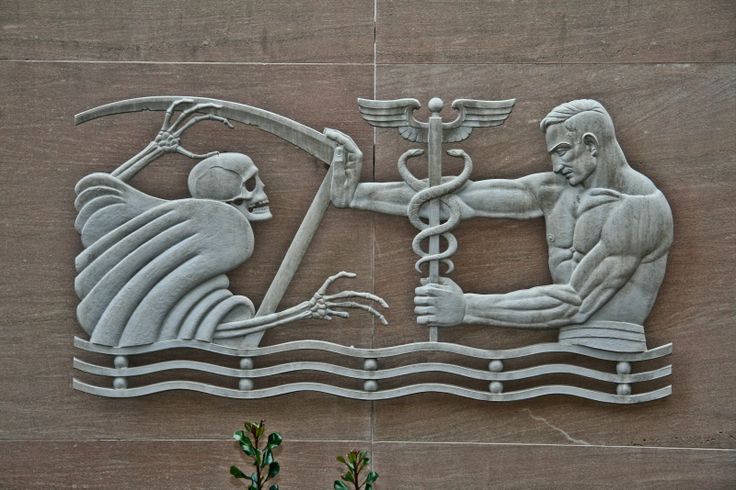
“Keeping Away Death” on The Fulton County Department of Health and Wellness
My first couple years in the funeral business nearly destroyed me. Growing up as the son of a funeral directing family, I had danced around death for most of my youth. When I finally danced with it upon full-time employment at my family’s funeral home, all I could see was darkness. I had a death negative narrative, a pair of lenses that viewed death as devoid of goodness and full of fear. I suppose most of us do.
In my book, I list five reasons this narrative is so strong; such as the professionalization of death care, the religious belief that death is a punishment for sin, and our evolutionary heritage. This narrative doesn’t exist in every culture, but it’s so strong for us in Western culture even death’s personification is this scary and dark figure we call the “Grim Reaper.”
The rise of the cold and bony Grim Reaper began during the 14th century, as the Black Death swept over Europe leaving anywhere from 25% to 60% of Europe’s population dead. Those infected suffered high fevers, seizers and possible gangrene of the extremities. Such an awful death produced a fear among the healthy, who regularly abandon their affected spouses and children. Not surprisingly, Death was depicted as the Grim Reaper, a bony figure with no flesh and no feeling with a scythe that mows down the living with reckless abandon. What is surprising is that this personification of Death didn’t die out with the Black Death, but remains THE depiction of death in Western culture today.
After my closeness with death nearly destroyed my own life, I knew that I’d either have to find something more in death, or I’d leave the business. As I searched, I began to see that death wasn’t entirely bad … it was deeply human. I write in my book, “I tremble to say there’s good in death, because I’ve looked in the eyes of the grieving mother and I’ve seen the heartbreak of the stricken widow, but I’ve also seen something more in death, something good. Death’s hands aren’t all cold and bony.”
Death isn’t the Grim Reaper. It isn’t unfeeling. It isn’t subhuman.
Marzanna is death personified in Baltic and Slavic lore. Unlike the “Grim Reaper” with the bony hands, or other popular personifications of death, Marzanna takes on the gender of a woman, as she’s not only associated with death but the rebirth of death in nature. Neil Gaiman brought a Marzanna type depiction to his comic book series, The Sandman. Gaiman’s Death is a beautiful, youth goth woman who is kind, relatable and nurturing. She’s nearly the exact opposite of the Reaper, a welcome sight to be sure, and one that continues to be a fan favorite.
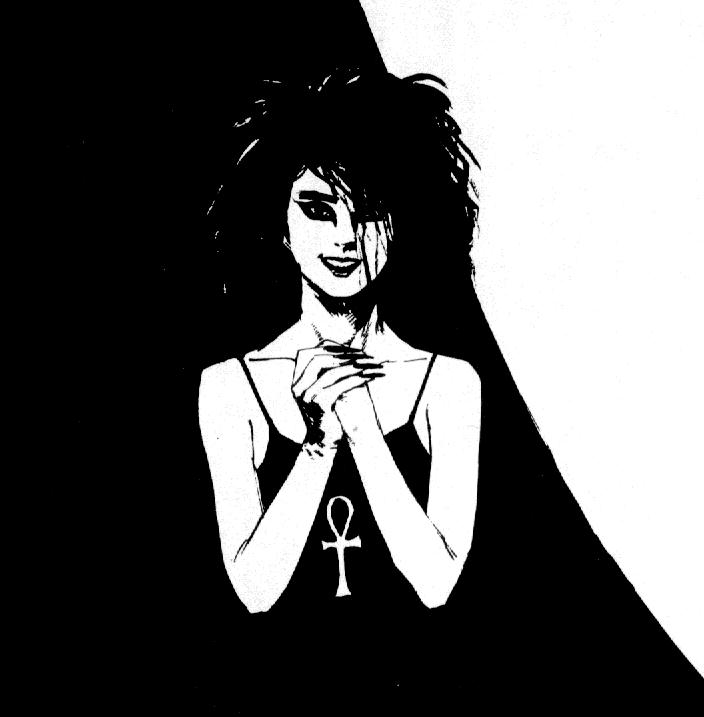
As much as I like Gaiman’s personification, there’s another personification of death that comes from St. Francis of Assisi (1181/1182 – 3 October 1226) that is more intimate still than Gaiman’s Death.
St. Francis committed his life to serving the poor, a commitment that inspired a following in the Catholic Church known as Franciscans, and a Pope who took Francis as his papal name. St. Francis of Assisi is also the patron saint of animals and nature, a facet of his life that is surrounded by folklore stories that tell of him preaching to birds and taming wolves. Folklore aside, St. Francis’ “Canticle of Brother Sun and Sister Moon” speaks of his intimacy with nature and love for it. In the Canticle, Francis goes through many of the natural occurrences — moon, sun, wind, water, fire, earth — framing each part as his sister or brother. To end the Canticle, Francis takes a surprising turn and thanks God for “Sister Death.”
As someone who felt deeply connected to nature, we shouldn’t be surprised that Francis saw Death as something intimate, something natural. Francis believed that all nature was good, although some of it needed redemption. It’s said that when Francis was dying, he told death to praise God, which was his way of calling death to not be painful or harrowing, but good. He believed death to be such an ingrained part of the natural order that it too — like all of nature — harbored a sense of goodness, even though it can often be cruel and terrifying. Like the fable of St. Francis and the wolf, he saw past the cruel and hoped for the good. According to the Transitus, at his life’s end, Francis proclaimed, “Welcome, Sister Death!”
Assisi’s “sister death” is a visage of death that asks us to see death as intimate, as something we’re deeply related to. It’s not some scary, distant creature of evil like the Grim Reaper, although neither is it a happy, painless experience. It isn’t something other than us, it’s a part of us. Death is ours. If we’re looking for the face of Death in a narrative that isn’t death negative, it’s St. Francis’ Sister Death, a face that closely resembles our own.
This reframing helps us interpret life’s end as something not cold and distant, but something that is entirely human. Death, after all, is ours. And I do believe if I had entered my dance with death with a different image, a different personification of Death, my view of it wouldn’t have been so disheartening. How we view death influences how we experience it. It’s time for a new visage, and maybe St. Assisi’s figure can help.
This is the first in a series of articles dealing with the “10 Confessions” of my book. If you’d like to order the book, click on the image below:

